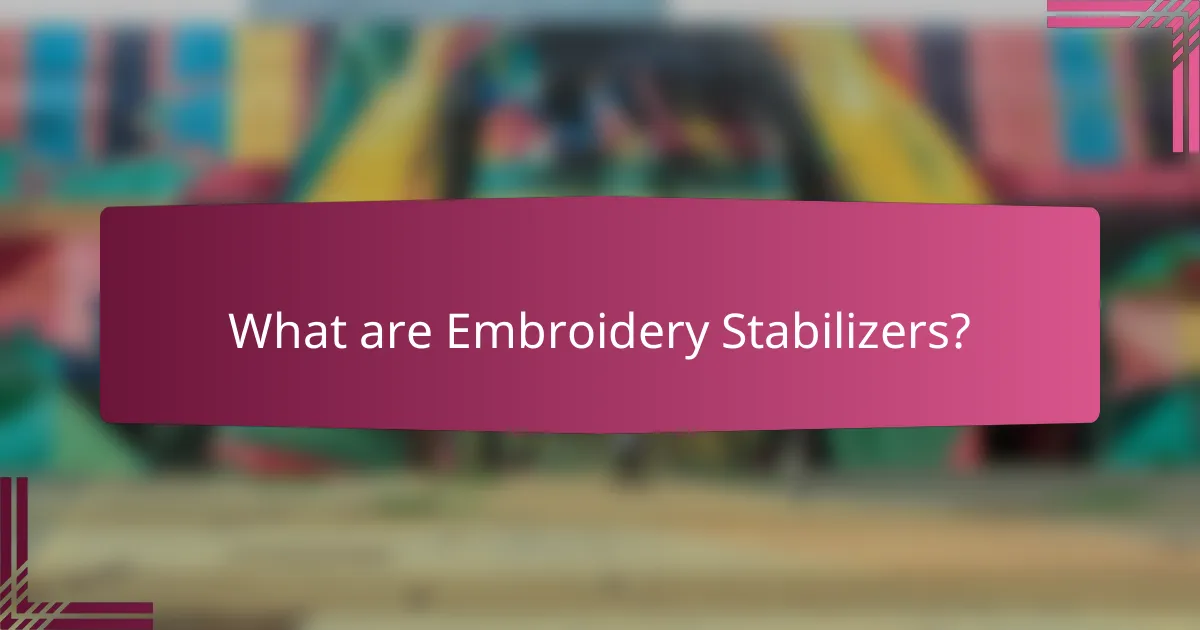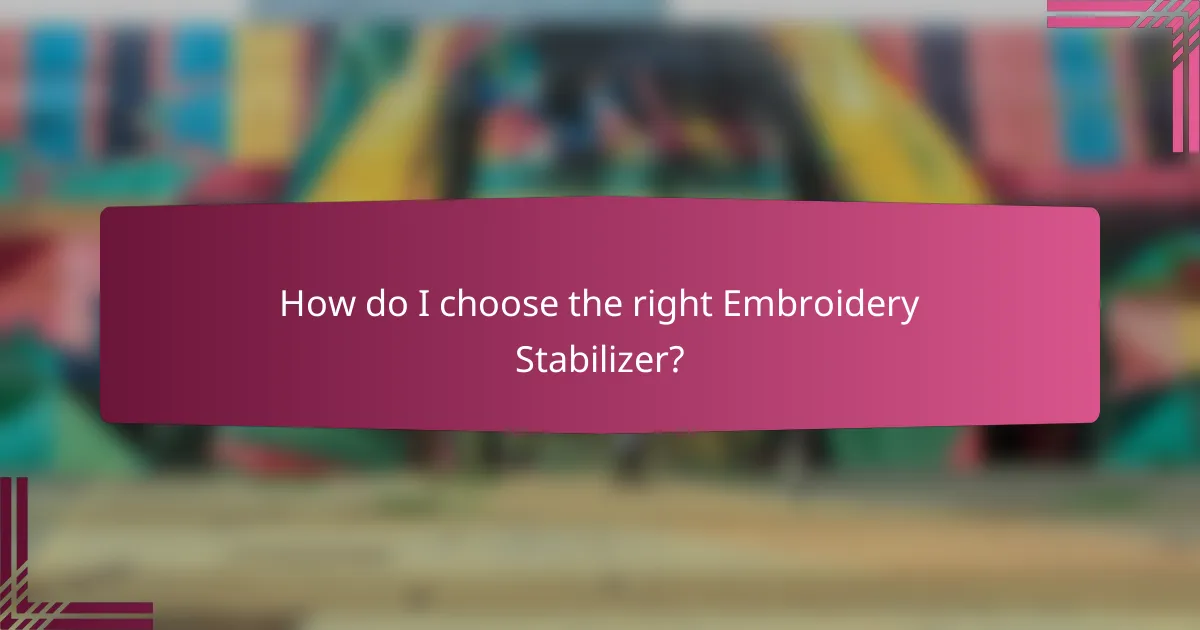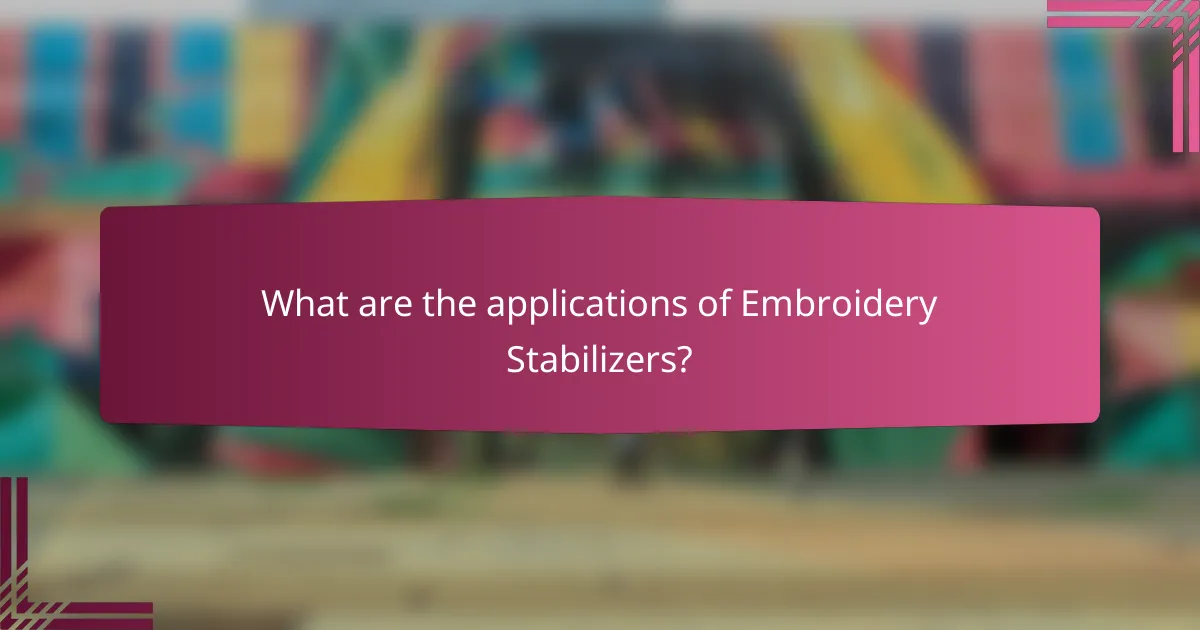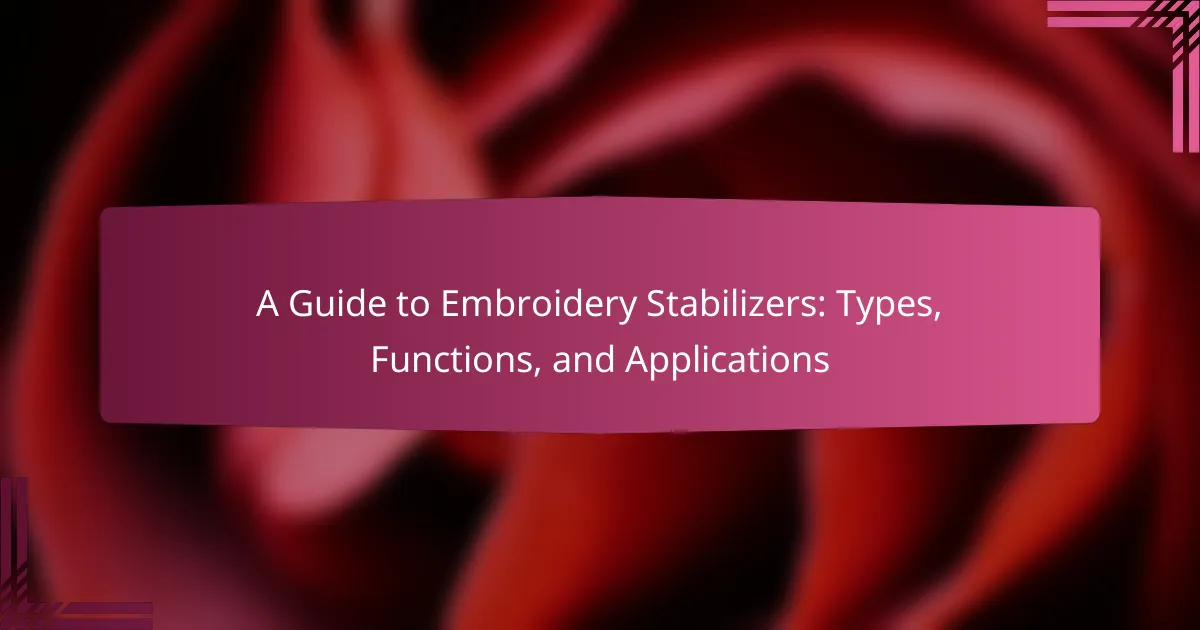
What are Embroidery Stabilizers?
Embroidery stabilizers are materials used to support fabric during the embroidery process. They prevent fabric distortion and ensure precise stitching. Stabilizers come in various types, including tear-away, cut-away, and water-soluble options. Each type serves a specific purpose based on the fabric and design. For example, tear-away stabilizers are easy to remove after stitching, while cut-away stabilizers remain with the fabric for added support. Water-soluble stabilizers dissolve in water, leaving no residue. Their use is essential for achieving high-quality embroidery results.
How do Embroidery Stabilizers work in the embroidery process?
Embroidery stabilizers support the fabric during the embroidery process. They prevent distortion and shifting of the fabric. Stabilizers maintain the fabric’s shape and ensure even stitching. They come in various forms, including tear-away, cut-away, and wash-away. Each type serves a specific purpose based on the fabric and design. For example, tear-away stabilizers are easy to remove after stitching. Cut-away stabilizers provide more support for dense designs. Wash-away stabilizers dissolve in water, leaving no residue. Using the correct stabilizer enhances the quality of the final embroidery.
What are the key components of Embroidery Stabilizers?
The key components of embroidery stabilizers include thickness, type, and adhesive properties. Thickness determines the level of support provided during embroidery. Types of stabilizers include tear-away, cut-away, and water-soluble, each serving different purposes. Adhesive properties affect how well the stabilizer adheres to the fabric. These components ensure proper tension and prevent fabric distortion during the embroidery process. Proper selection of these components is crucial for achieving high-quality embroidery results.
How do different materials affect the performance of Embroidery Stabilizers?
Different materials significantly affect the performance of embroidery stabilizers. Each stabilizer type, such as cut-away, tear-away, and water-soluble, serves distinct purposes based on the fabric used. For instance, cut-away stabilizers provide support for dense designs on stretchy fabrics. They prevent distortion during stitching and maintain shape after washing. Tear-away stabilizers are effective for lightweight fabrics. They allow for easy removal without damaging the fabric. Water-soluble stabilizers are ideal for delicate or intricate designs. They dissolve completely, leaving no residue. The choice of material impacts the final embroidery quality, durability, and ease of use. Selecting the right stabilizer material ensures optimal results in embroidery projects.
What are the different types of Embroidery Stabilizers?
There are several types of embroidery stabilizers. The main categories include cut-away, tear-away, wash-away, and fusible stabilizers. Cut-away stabilizers provide support for dense designs and are removed by cutting. Tear-away stabilizers are easy to remove by tearing, suitable for lightweight fabrics. Wash-away stabilizers dissolve in water, ideal for delicate fabrics and intricate designs. Fusible stabilizers adhere to the fabric when heat is applied, providing extra stability. Each type serves a specific purpose in embroidery, ensuring the quality and durability of the finished product.
What are cut-away stabilizers and when should they be used?
Cut-away stabilizers are a type of embroidery stabilizer that remains in place after stitching. They provide support for dense designs and prevent distortion during the embroidery process. Cut-away stabilizers are ideal for fabrics that are stretchy or have a loose weave. They are often used for knit fabrics, t-shirts, and items that require durability. The stabilizer is trimmed away after the embroidery is complete, leaving a clean finish. This type of stabilizer is especially beneficial for designs with heavy stitching. It helps maintain the shape and integrity of the fabric.
How do tear-away stabilizers differ from cut-away stabilizers?
Tear-away stabilizers differ from cut-away stabilizers in their removal process. Tear-away stabilizers can be easily torn away from the fabric after embroidery. This makes them suitable for projects where a clean finish is desired without additional trimming. In contrast, cut-away stabilizers require cutting away the excess stabilizer after embroidery. They provide more support for dense designs and stretchy fabrics. Cut-away stabilizers remain on the fabric, offering stability and preventing distortion over time. This characteristic makes them ideal for items that will undergo repeated washing or stretching.
What are water-soluble stabilizers and their applications?
Water-soluble stabilizers are materials used in embroidery that dissolve in water. They provide support during the stitching process. Once the embroidery is complete, they can be rinsed away, leaving only the thread design. This type of stabilizer is ideal for delicate fabrics and intricate designs. Common applications include free-standing lace and sheer fabrics. They help prevent fabric distortion and maintain the integrity of the embroidery. Water-soluble stabilizers are available in sheets, rolls, and sprays. Their versatility makes them a popular choice among embroiderers.
What role do adhesive stabilizers play in embroidery?
Adhesive stabilizers provide support and hold fabric in place during embroidery. They help prevent shifting and distortion of the fabric while stitching. This ensures accurate and clean embroidery designs. Adhesive stabilizers are particularly useful for lightweight or slippery fabrics. They can be temporary or permanent, depending on the project needs. Temporary adhesive stabilizers wash away easily after use. Permanent options remain with the fabric for durability. Their application enhances the overall quality of the finished embroidery.
What functions do Embroidery Stabilizers serve?
Embroidery stabilizers serve several essential functions in the embroidery process. They provide support to the fabric during stitching. This support prevents fabric distortion and puckering. Stabilizers also help maintain the quality of the embroidery design. They ensure that stitches are evenly spaced and secure. Additionally, they can enhance the overall appearance of the finished piece. Different types of stabilizers cater to various fabric types and embroidery techniques. For instance, tear-away stabilizers are easy to remove after stitching, while cut-away stabilizers offer lasting support. These functions collectively contribute to achieving professional-quality embroidery results.
How do Stabilizers prevent fabric distortion during embroidery?
Stabilizers prevent fabric distortion during embroidery by providing support and structure. They stabilize the fabric layers, reducing movement during stitching. This support helps maintain the fabric’s original shape. Different types of stabilizers offer varying levels of firmness. For example, tear-away stabilizers allow easy removal after embroidery. Cut-away stabilizers provide lasting support, ideal for stretchy fabrics. Additionally, water-soluble stabilizers dissolve in water, leaving no residue. Proper use of stabilizers enhances stitch quality and prevents puckering. Studies show that using stabilizers can significantly improve embroidery outcomes.
Why is it important to choose the right Stabilizer for different fabrics?
Choosing the right stabilizer for different fabrics is crucial for achieving quality embroidery results. Each fabric type has unique characteristics that require specific stabilizer properties. For example, lightweight fabrics need a lighter stabilizer to prevent distortion. Heavier fabrics may require a more robust stabilizer to maintain structure.
Using an inappropriate stabilizer can lead to issues such as puckering, misalignment, or fabric damage. The right stabilizer enhances the embroidery’s appearance and durability. It also ensures that the design stitches out correctly without compromising the fabric’s integrity.
For instance, using a tear-away stabilizer for knits can cause the fabric to stretch and warp. Conversely, a cut-away stabilizer provides the needed support for intricate designs on stretchy materials. Therefore, selecting the correct stabilizer is essential for achieving professional-looking embroidery.
How do Stabilizers enhance the quality of the finished embroidery?
Stabilizers enhance the quality of finished embroidery by providing support during the stitching process. They prevent fabric distortion and ensure that stitches are evenly placed. This results in sharper, more defined designs. Stabilizers also help to reduce puckering and fraying. They maintain the integrity of the fabric, allowing for cleaner edges. Different types of stabilizers can be used depending on the fabric and design complexity. For example, tear-away stabilizers are ideal for lightweight fabrics. Overall, using the correct stabilizer contributes to a professional and polished final product.

How do I choose the right Embroidery Stabilizer?
To choose the right embroidery stabilizer, consider the fabric type and project requirements. Different fabrics require specific stabilizers to prevent distortion. For lightweight fabrics, use tear-away or cut-away stabilizers. For heavier fabrics, consider using a thicker cut-away stabilizer. Assess the embroidery design complexity; intricate designs benefit from more support. Additionally, consider the washability of the stabilizer based on the end-use of the item. Finally, always test the stabilizer with a sample stitch-out to ensure compatibility.
What factors should I consider when selecting an Embroidery Stabilizer?
When selecting an embroidery stabilizer, consider the type of fabric you are using. Different fabrics require specific stabilizers for optimal results. The weight of the stabilizer is also crucial; heavier stabilizers support dense designs, while lighter ones are suitable for delicate fabrics. Additionally, assess whether the stabilizer is tear-away, cut-away, or wash-away, as each type serves different purposes. The design complexity impacts stabilizer choice; intricate designs may need a more robust stabilizer. Finally, consider the intended use of the finished embroidery, as this will influence the durability required from the stabilizer.
How does fabric type influence Stabilizer choice?
Fabric type significantly influences stabilizer choice in embroidery. Different fabrics have unique characteristics that require specific stabilizers for optimal results. For instance, lightweight fabrics like silk need a tear-away or wash-away stabilizer to prevent distortion. Heavier fabrics, such as denim, often require a cut-away stabilizer for better support. Stretchy fabrics, like knits, benefit from a stabilizer that allows for flexibility, such as a fusible or specialty stabilizer. The choice of stabilizer also impacts the final appearance of the embroidery. Using the appropriate stabilizer ensures clean edges and prevents puckering during stitching.
What is the significance of design complexity in Stabilizer selection?
Design complexity significantly influences stabilizer selection in embroidery. More intricate designs require stabilizers that provide greater support. This ensures the fabric maintains its shape during stitching. Complex designs often involve multiple layers or fine details. A suitable stabilizer prevents distortion and puckering. For example, dense stitch patterns benefit from tear-away or cut-away stabilizers. These stabilizers offer the necessary rigidity. In contrast, simpler designs may only need lightweight stabilizers. The right choice enhances the overall quality of the embroidery.
What are common mistakes to avoid when using Embroidery Stabilizers?
Common mistakes to avoid when using embroidery stabilizers include selecting the wrong type for the fabric. Each fabric requires a specific stabilizer, such as tear-away or cut-away. Not testing the stabilizer before starting a project can lead to poor results. It’s crucial to perform a test stitch on a scrap piece. Additionally, using too much or too little stabilizer can affect the final outcome. Proper measurements are essential for effective use. Ignoring the manufacturer’s instructions can result in suboptimal performance. Finally, not adjusting the tension settings on the embroidery machine may cause puckering or distortion.
How can improper Stabilizer choice affect the final product?
Improper stabilizer choice can lead to issues such as distortion, puckering, and inadequate support in the final product. When a stabilizer is not suited to the fabric or design, it may fail to provide the necessary rigidity. This can result in uneven stitching and loss of detail in the embroidery. Additionally, some stabilizers may leave residues or cause fabric damage during removal. Research indicates that using the wrong stabilizer can compromise the longevity and appearance of the finished piece. For instance, a lightweight stabilizer on a heavy fabric can lead to poor results. Thus, selecting the appropriate stabilizer is crucial for achieving high-quality embroidery.
What are the consequences of using multiple types of Stabilizers incorrectly?
Using multiple types of stabilizers incorrectly can lead to various negative consequences. These consequences include fabric distortion, uneven stitching, and poor design clarity. When stabilizers are mismatched, they can fail to provide adequate support during the embroidery process. This results in puckering or bunching of the fabric. Additionally, the wrong stabilizer may not adhere properly, causing the design to shift. Inconsistent stabilizer types can also lead to thread breakage and increased wear on the machine. Ultimately, these issues can compromise the overall quality of the embroidery project.

What are the applications of Embroidery Stabilizers?
Embroidery stabilizers are used to support fabric during the embroidery process. They prevent distortion and ensure clean, precise stitching. Common applications include use with lightweight fabrics to prevent puckering. They are also essential for intricate designs that require stability. Additionally, stabilizers help maintain the shape of embroidered items after washing. They can be used in quilting to stabilize layers. Different types, such as tear-away or cut-away, serve specific purposes based on the fabric type and design complexity. Overall, embroidery stabilizers enhance the quality and durability of embroidered projects.
In which industries are Embroidery Stabilizers commonly used?
Embroidery stabilizers are commonly used in the textile and apparel industry. They provide support during the embroidery process to prevent distortion. This application is crucial for maintaining the quality of embroidered designs. Additionally, the craft and hobby industry utilizes stabilizers for personal projects. They are essential for home embroidery machines, ensuring clean and precise results. The promotional products industry also relies on stabilizers for custom embroidered items. These industries benefit from stabilizers to enhance both functionality and aesthetics in their products.
How do Embroidery Stabilizers benefit the fashion industry?
Embroidery stabilizers benefit the fashion industry by providing essential support during the embroidery process. They prevent fabric distortion and ensure that designs maintain their shape. This support enhances the quality of the final product, leading to more professional-looking garments. Stabilizers come in various types, such as tear-away, cut-away, and water-soluble, each serving specific needs. For instance, tear-away stabilizers are easy to remove, while cut-away stabilizers offer lasting support for stretchy fabrics. The use of stabilizers can also reduce thread breaks and improve stitching accuracy. This results in less wasted material and lower production costs. Ultimately, embroidery stabilizers contribute to higher efficiency and better overall quality in fashion production.
What role do Stabilizers play in home embroidery projects?
Stabilizers are essential in home embroidery projects as they provide support to the fabric during the stitching process. They prevent distortion and maintain the shape of the design. Stabilizers come in various types, such as tear-away, cut-away, and wash-away. Each type serves a specific purpose based on the fabric and design complexity. For instance, tear-away stabilizers are ideal for lightweight fabrics, while cut-away stabilizers are better for stretchy materials. Using the appropriate stabilizer enhances the quality of the embroidery. According to industry standards, proper stabilizer use can reduce fabric puckering by up to 70%. This demonstrates their critical role in achieving professional-looking results in embroidery projects.
What are some tips for using Embroidery Stabilizers effectively?
Select the appropriate stabilizer for your fabric type. Different fabrics require different stabilizers for optimal results. Use tear-away stabilizers for lightweight fabrics and cut-away stabilizers for heavier materials. Ensure the stabilizer is hooped tightly with the fabric. A tight hoop prevents shifting during stitching. Test the stabilizer before starting your project. Conduct a stitch test to check compatibility and performance. Adjust tension settings based on the stabilizer used. Proper tension helps achieve clean and professional-looking stitches. Remove excess stabilizer carefully after embroidery. This prevents damage to the finished design. Store stabilizers properly to maintain their quality. Keep them in a cool, dry place away from direct sunlight.
How can I ensure the best results with my chosen Stabilizer?
Select the appropriate stabilizer for your fabric type. For instance, lightweight fabrics benefit from tear-away stabilizers. Ensure the stabilizer is hooped tightly with the fabric. This prevents shifting during the embroidery process. Adjust your embroidery machine settings based on the stabilizer type. For example, use a lower stitch density for thicker stabilizers. Test your chosen stabilizer with a sample stitch-out before the final project. This helps identify any issues early on. Following these steps maximizes the effectiveness of your stabilizer and enhances the overall embroidery quality.
What maintenance practices should I follow for my Stabilizers?
Regular cleaning is essential for maintaining stabilizers. Remove any excess threads or fabric after each use. Store stabilizers in a cool, dry place to prevent moisture damage. Avoid exposure to direct sunlight, which can degrade materials. Check for any signs of wear or damage before each use. Replace any stabilizers that show significant wear. Following these practices extends the life of your stabilizers.
Embroidery stabilizers are essential materials used to support fabric during the embroidery process, preventing distortion and ensuring precise stitching. This guide covers the various types of stabilizers, including tear-away, cut-away, and water-soluble options, each serving specific purposes based on fabric type and design complexity. Key components such as thickness, adhesive properties, and their impact on embroidery quality are examined, alongside common mistakes to avoid and tips for effective use. The article also explores the applications of stabilizers across different industries, highlighting their significance in achieving professional-quality embroidery results.
